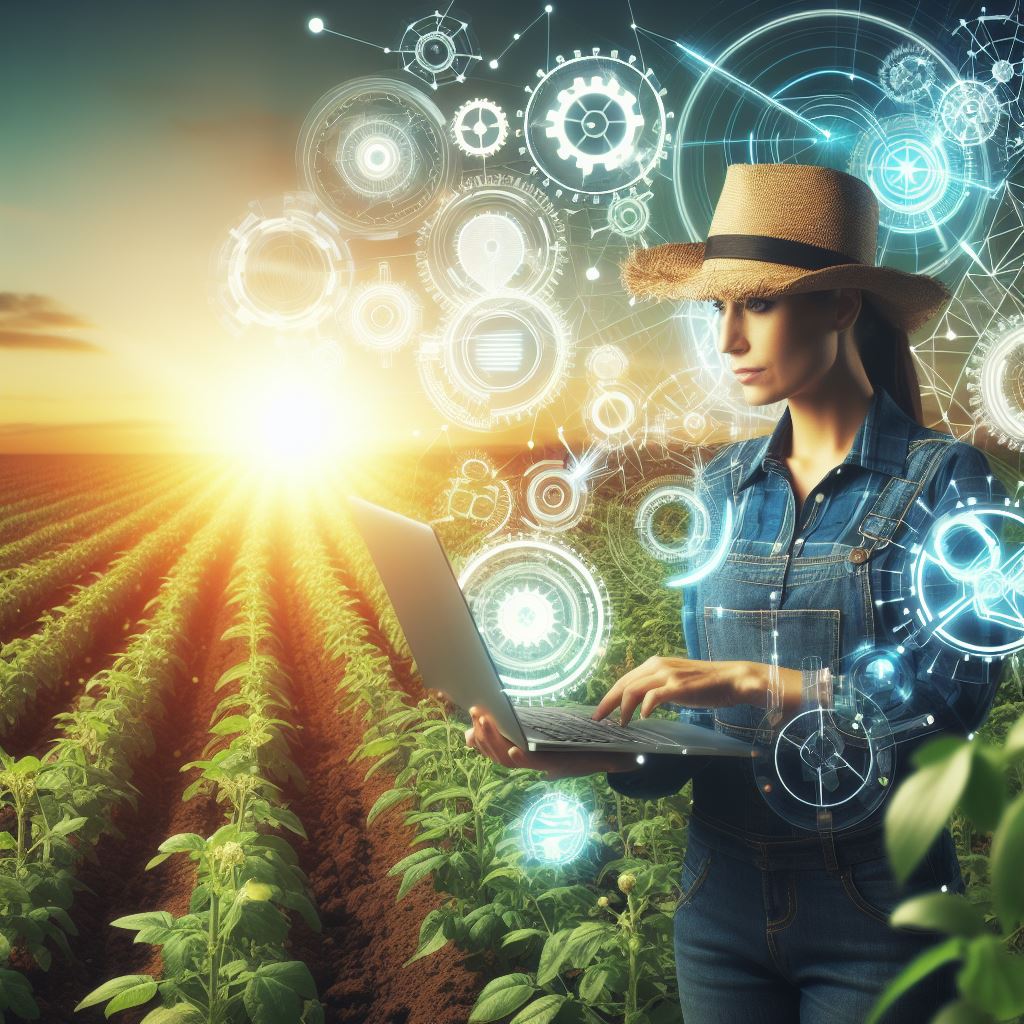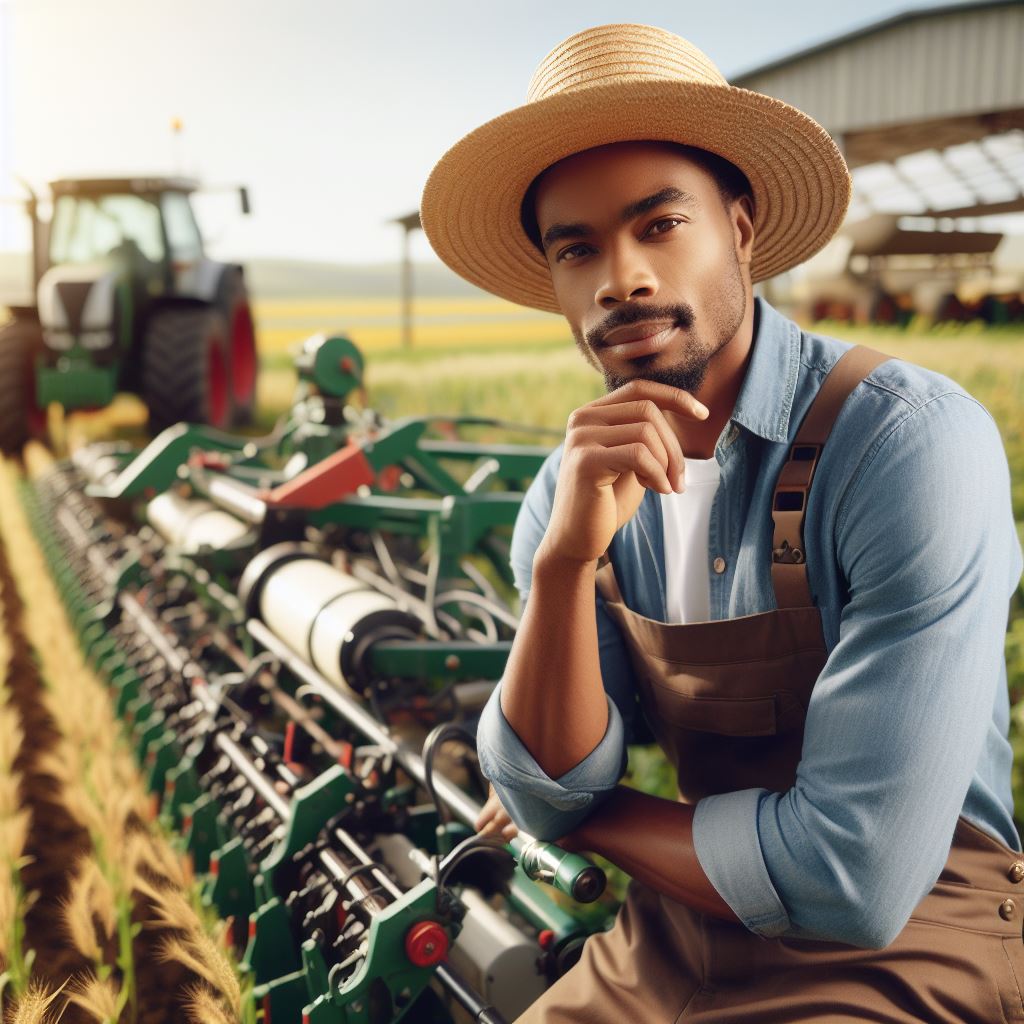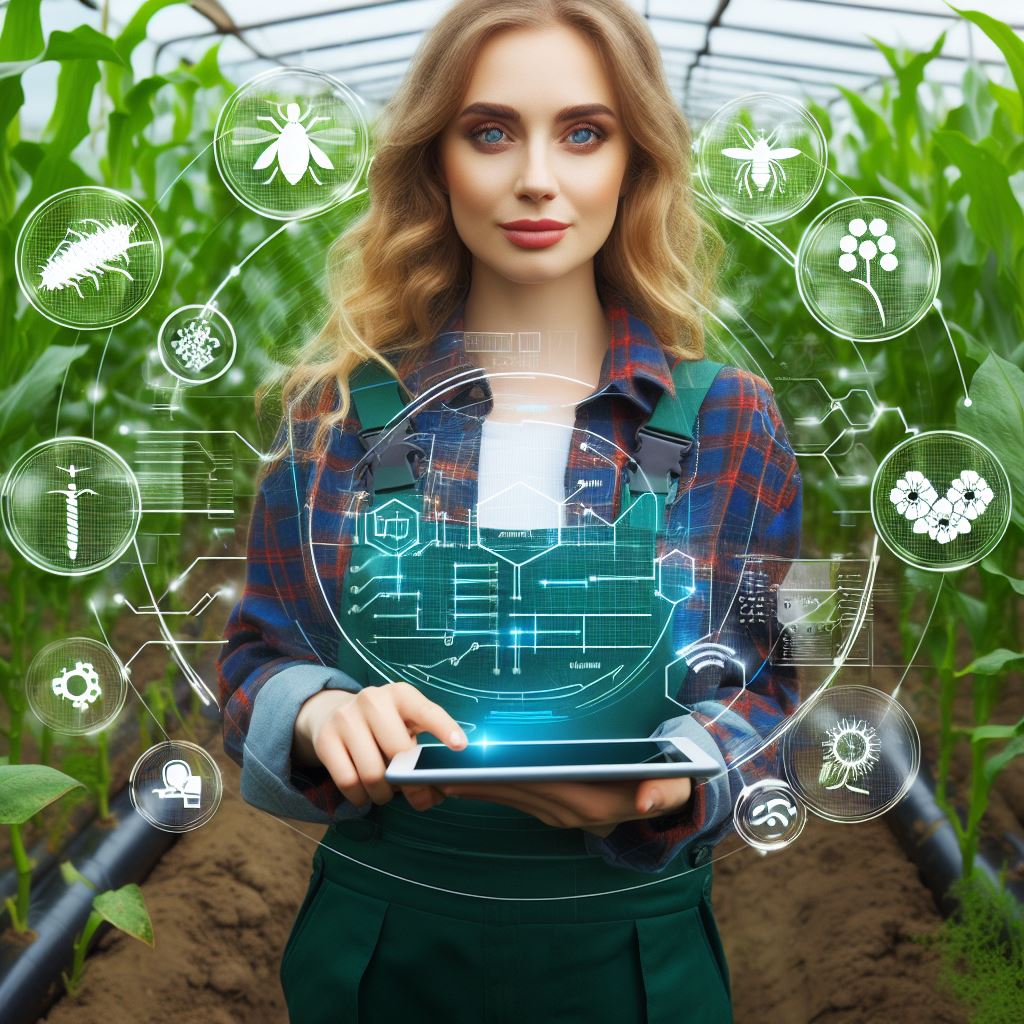Introduction
In the realm of agriculture, the integration of Artificial Intelligence (AI) and Robotics has ushered in a transformative era.
These advanced technologies are not only reshaping various industries but are also playing a pivotal role in revolutionizing crop management.
The marriage of AI and robotics brings unprecedented efficiency to crop management practices.
Automation, data analytics, and machine learning are among the key elements driving this revolution.
Industries across the board have witnessed significant transformations through the adoption of AI and robotics.
From manufacturing to healthcare, these technologies have enhanced productivity and precision.
In agriculture, the impact is particularly profound, addressing the evolving challenges of the sector.
The Importance of AI and Robotics in Crop Management
- Precision Agriculture: AI and robotics enable precision agriculture, where every aspect of crop management is finely tuned. This results in optimized resource use and increased yield.
- Data-Driven Decision Making: The ability to collect and analyze vast amounts of data empowers farmers to make informed decisions. AI algorithms process data in real-time, offering insights into crop health, soil conditions, and weather patterns.
- Efficient Crop Monitoring: Drones equipped with AI capabilities can monitor large fields efficiently. They provide visual data on crop health, allowing for early detection of diseases or pests.
- Automated Planting and Harvesting: Robotics streamline labor-intensive tasks such as planting and harvesting. Automated machinery ensures accuracy and speed, reducing the dependency on manual labor.
- Resource Optimization: AI algorithms analyze factors like soil composition and weather conditions to optimize the use of water, fertilizers, and pesticides. This not only conserves resources but also minimizes environmental impact.
- Crop Health Management: AI-powered sensors can detect subtle changes in crop health, enabling proactive measures. This early intervention helps prevent potential crop losses.
- Adaptability to Climate Change: AI and robotics facilitate adaptive strategies in response to changing climate conditions. The technologies allow for the timely adjustment of cultivation practices to mitigate the impact of climate change on crop yields.
- Enhanced Efficiency and Sustainability: By automating repetitive tasks, AI and robotics enhance overall farm efficiency. This not only benefits farmers economically but also contributes to sustainable agricultural practices.
In fact, the integration of AI and robotics marks a revolutionary shift in crop management.
These technologies empower farmers with data-driven insights, precision agriculture, and automated processes, ultimately contributing to increased productivity, resource efficiency, and sustainability in the agricultural sector.
Advancements in AI for Crop Management
Use of Machine Learning Algorithms in Analyzing Crop Data
- Machine learning algorithms play a crucial role in analyzing vast amounts of crop data.
- These algorithms can identify patterns and make useful predictions based on historical data.
- By examining factors like weather, soil condition, and pest infestations, AI can determine potential crop diseases.
- Using decision trees and regression analysis, algorithms assist farmers in making informed decisions.
- These algorithms enable the optimization of irrigation, fertilization, and pest control resulting in higher crop yields.
AI’s Role in Predicting Crop Yields and Optimizing Resources
- AI systems can analyze crop data to predict yields with impressive accuracy.
- By considering historical data, weather patterns, and soil conditions, AI models can estimate future crop outputs.
- This information helps farmers make data-driven decisions regarding planting schedules, resource allocation, and market planning.
- Optimizing resource allocation reduces wastage and maximizes productivity, leading to improved profitability.
- AI-powered systems enable precision agriculture, ensuring efficient use of water, fertilizers, and pesticides.
Use of AI-Powered Drones for Monitoring Crop Health
- AI-powered drones offer a revolutionary way to monitor crop health and identify potential issues.
- Equipped with advanced sensors, drones capture high-resolution images of the crops.
- AI algorithms can analyze these images to detect signs of pest infestation, nutrient deficiencies, or diseases.
- By identifying problems in early stages, farmers can take proactive measures to prevent crop damage.
- Additionally, these drones can evaluate plant growth and provide valuable insights for improved cultivation practices.
As technology continues to advance, AI and robotics are set to revolutionize crop management.
The use of machine learning algorithms allows for enhanced analysis of crop data.
Through accurate predictions of crop yields, farmers can optimize their resources effectively.
AI-powered drones provide a real-time monitoring solution to maintain optimal crop health.
The integration of AI and robotics in crop management offers immense potential for the agriculture industry.
Read: Cotton Cultivation: Best Practices and Tips
Role of Robotics in Crop Management
The concept of agricultural robots and their applications
Agricultural robots are machines designed to assist farmers in various tasks, improving productivity and precision.
These robots are equipped with advanced sensors and software, enabling them to perform complex agricultural operations.
They can be used for tasks such as soil monitoring, seeding, spraying fertilizers, and monitoring crop health.
Agricultural robots make farming more efficient and sustainable by reducing manual labor and enhancing crop productivity.
They contribute to the implementation of precision agriculture techniques, allowing farmers to optimize resource utilization.
Furthermore, these robots can collect and analyze valuable data, providing insights for decision-making in crop management.
The use of robotic arms in planting, harvesting, and sorting crops
Robotic arms play a crucial role in critical crop management tasks like planting, harvesting, and sorting crops.
In the planting process, these robotic arms can accurately place seeds in the soil at optimized depths, ensuring uniform distribution.
During harvesting, they delicately pick fruits or vegetables without damaging the produce, ensuring higher quality yield.
Robotic arms also excel in sorting crops, efficiently classifying them based on size, color, quality, or any other specified criteria.
The use of robotic arms in crop management reduces human labor requirements and increases the precision of these tasks.
As a result, farmers can save time and resources while maintaining produce quality and maximizing output.
The benefits of robotics in reducing labor costs and maximizing efficiency
Robotics offers significant benefits to farmers, primarily by reducing labor costs and maximizing overall efficiency.
By automating time-consuming and labor-intensive tasks, farmers can allocate their workforce to other essential operations.
This reduction in labor costs helps agricultural businesses remain competitive and financially sustainable.
Furthermore, robotics enables precise and targeted application of resources such as fertilizers and pesticides.
This targeted approach minimizes wastage, reduces environmental impact, and optimizes resource utilization.
Robotic systems also offer better data collection capabilities, allowing farmers to make informed decisions based on real-time insights.
The integration of artificial intelligence in robotics enhances decision-making, optimizing crop management practices.
Overall, robotics in crop management streamlines various processes, enhances productivity, and increases profitability.
In short, agricultural robots, equipped with advanced sensors and software, revolutionize crop management practices.
They assist farmers in numerous tasks, including soil monitoring, seeding, fertilizing, and crop health monitoring.
Robotic arms play a vital role in planting, harvesting, and sorting crops with precision and efficiency.
The use of robots in these tasks significantly reduces labor costs and maximizes overall operational efficiency.
Moreover, robotics contributes to sustainable farming practices by optimizing resource utilization and reducing environmental impact.
Through their data collection and analysis capabilities, robots provide valuable insights for informed decision-making.
As technology continues to advance, the role of robotics in crop management will only continue to expand, benefiting farmers worldwide.
Read: Integrated Pest Management for Fruit Trees
Transform Your Agribusiness
Unlock your farm's potential with expert advice tailored to your needs. Get actionable steps that drive real results.
Get StartedIntegration of AI and Robotics in Crop Management
Examples of AI-powered robots used in precision farming
SwagBot, an autonomous robot that helps with monitoring and herding livestock.
Tomo, a robot capable of autonomously harvesting cucumbers in greenhouses.
The TerraSentia robot, designed for weed detection and plant phenotyping in crop fields.
Blue River’s See & Spray, a robot equipped with computer vision to target and eliminate weeds precisely.
Energid’s Actin-based robots, used in harvesting fruits and vegetables with delicate handling.
AI and robotics work together to automate farming tasks
AI and robotics combine to automate farming tasks by gathering data, analyzing it, and executing actions accordingly.
The integration of AI allows robots to make informed decisions based on patterns and data inputs.
Robotic systems equipped with sensors and cameras can collect data on plant health, soil conditions, and weed presence.
The collected data is then analyzed by AI algorithms to gain insights and detect anomalies or potential issues.
AI-powered robots can perform precise interventions, such as targeted spraying or selective harvesting, minimizing waste.
The use of machine learning and predictive modeling enables robots to optimize resource allocation and yield maximization.
The potential challenges and limitations of AI and robotics in crop management
High initial costs can be a barrier to widespread adoption of AI and robotics in crop management.
Lack of skilled personnel for maintaining and repairing complex robotic systems.
Integration challenges when implementing AI systems into existing farming practices and infrastructure.
Privacy and data security concerns regarding the collection and management of sensitive farming data.
Environmental and ethical considerations, as increased automation might lead to job displacement or loss.
Unpredictability of weather conditions and natural disasters can affect the efficiency and reliability of AI and robotic systems.
Reliance on stable and accessible connectivity for receiving real-time data and remote control of robotic devices.
Potential biases or errors in AI algorithms that could lead to inaccurate decision-making.
In general, the integration of AI and robotics in crop management holds immense potential for revolutionizing the agriculture industry.
AI-powered robots offer innovative solutions for precision farming, enabling tasks such as monitoring livestock, harvesting crops, and weed detection.
By combining AI’s data analysis capabilities with robots’ physical abilities, farming processes can be automated and optimized for better resource allocation and higher yields.
However, challenges such as high costs, lack of skilled personnel, integration difficulties, and ethical concerns need to be addressed for broader adoption.
Despite these limitations, the collaboration between AI and robotics paves the way for more sustainable and efficient crop management practices, leading to increased productivity and food security in a rapidly changing world.
Read: Hydroponics: Future of Urban Crop Production

Impacts and Benefits of AI and Robotics in Crop Management
Improved Crop Quality and Quantity
AI and robotics play a crucial role in enhancing crop quality by identifying diseases, pests, and nutrient deficiencies at an early stage.
Using advanced imaging technologies, these systems can precisely analyze plant health indicators and provide targeted treatments.
Robotic tools equipped with AI algorithms can perform tasks such as seed planting, irrigation, and harvesting with unmatched accuracy and efficiency.
Showcase Your Farming Business
Publish your professional farming services profile on our blog for a one-time fee of $200 and reach a dedicated audience of farmers and agribusiness owners.
Publish Your ProfileThis level of precision ensures optimal conditions for crop growth, resulting in higher yields and better-quality produce.
Potential Savings in Resources and Increased Profitability
The implementation of AI and robotics in crop management can lead to significant savings in resources and increased profitability for farmers.
Robots can autonomously perform labor-intensive tasks, reducing the dependency on human labor and saving costs associated with hiring and managing a workforce.
AI-powered systems can analyze various factors such as soil composition, weather patterns, and crop health to optimize resource allocation, minimizing waste.
Farmers can save substantial amounts of water, fertilizer, and pesticides by precisely targeting where and when they are needed, resulting in cost reduction.
Moreover, the increased productivity and efficiency achieved through AI and robotics can lead to greater profits for farmers.
Environmental Benefits of Reducing Chemical Usage and Waste
The use of AI and robotics in crop management can have significant environmental benefits by reducing chemical usage and waste.
AI algorithms can accurately detect pest infestations and diseases, allowing for targeted application of pesticides and minimizing their overall use.
This precision-based approach reduces the potential harm to beneficial insects, biodiversity, and water sources.
Robotic systems can also utilize precise techniques for the application of fertilizers, preventing excess runoff and minimizing soil and water contamination.
With AI and robotics, farmers can adopt more sustainable practices, reducing their ecological footprint and contributing to environmental conservation.
In review, the integration of AI and robotics in crop management brings numerous impacts and benefits.
From improving crop quality and quantity to potential cost savings and increased profitability for farmers, the advantages are significant.
Additionally, reducing chemical usage and waste through precise application methods helps protect the environment and promote sustainability in agriculture.
The revolutionized approach of AI and robotics in crop management is transforming the way we grow food, paving the way for a more efficient and sustainable future.
Read: Preventing Soil Erosion in Crop Fields
Future Prospects and Challenges
Potential Future Advancements in AI and Robotics for Crop Management
- Integration of AI and robotics can maximize crop yields and reduce manual labor.
- Advanced robotic systems can autonomously monitor crops, detect diseases, and apply targeted treatments.
- AI algorithms can analyze big data to provide real-time insights and optimize farming strategies.
- Robotic devices equipped with AI can navigate through complex terrains and overcome obstacles.
- Future advancements may include the development of robots with improved precision and adaptability.
Challenges in Implementing AI and Robotics at Scale
- High initial investment and maintenance costs pose a challenge for widespread adoption.
- Technical complexities, such as integration with existing infrastructure and variability in crop types, require careful implementation.
- Skilled workforce and training programs are needed to operate and maintain advanced AI and robotic systems.
- Acceptance and trust among farmers and the agriculture community may be slow due to unfamiliarity with emerging technologies.
- The potential for job displacement and the need for human oversight in decision-making are concerns.
Need for Regulations and Ethical Considerations in AI and Robotics
- Regulations must be established to ensure the safety and responsible use of AI and robotic systems.
- Ethical considerations need to be addressed to prevent misuse or unintended consequences.
- Standards should be set to safeguard data privacy and protect intellectual property.
- Transparent decision-making algorithms should be developed to ensure fairness and accountability.
- Collaborations between stakeholders, including farmers, researchers, and policymakers, are essential to address these challenges.
In summary, the future prospects of AI and robotics in crop management are promising.
Advancements in these technologies can revolutionize farming practices, leading to increased productivity and sustainability.
However, challenges, such as cost, implementation complexities, and ethical considerations, must be overcome.
Regulations and ethical frameworks need to be established to ensure responsible and equitable adoption of AI and robotic systems.
With collaboration and continuous innovation, the agricultural industry can harness the full potential of AI and robotics for efficient crop management.
Conclusion
A revolution is underway in crop management fueled by the transformative potential of AI and robotics.
These technologies have revolutionized the way we approach farming, enabling increased efficiency, precision, and productivity.
By embracing AI and robotics, we can optimize resource utilization, reduce environmental impact, and ensure sustainable agriculture for future generations.
It is vital for farmers, researchers, and stakeholders to stay updated with the latest developments in this rapidly evolving field.
With continuous advancements, we can expect even more innovative solutions to address the challenges of crop management.
By harnessing the power of AI and robotics, we can achieve higher yields, reduce labor-intensive tasks, and enhance overall food production.
Let us be at the forefront of this agricultural revolution, embracing technology for a greener and more sustainable future.
Together, we can empower farmers to make informed decisions and revolutionize the way crops are managed.
Stay informed, keep learning, and contribute to the advancement of AI and robotics in crop management!




